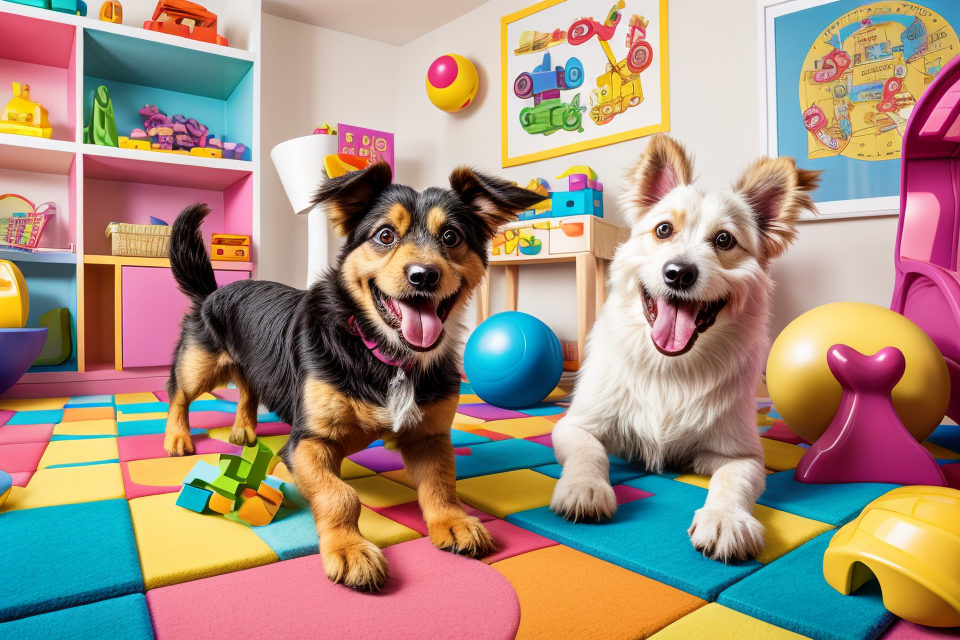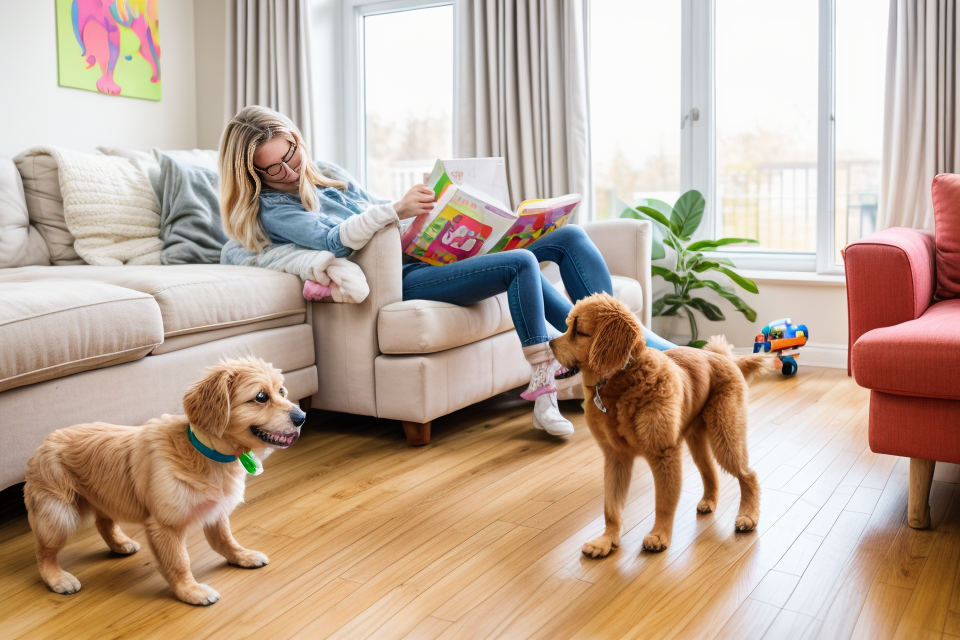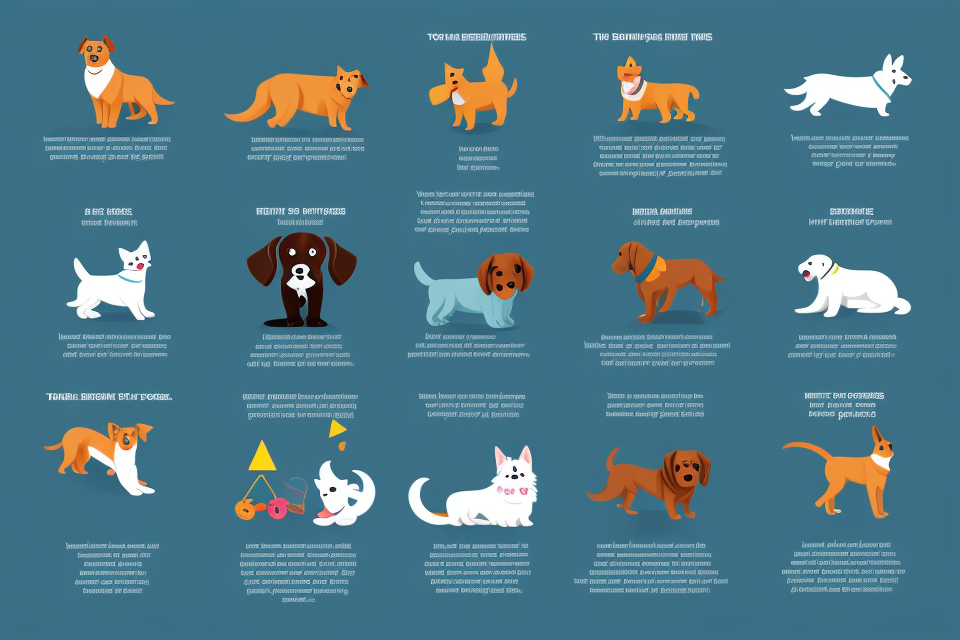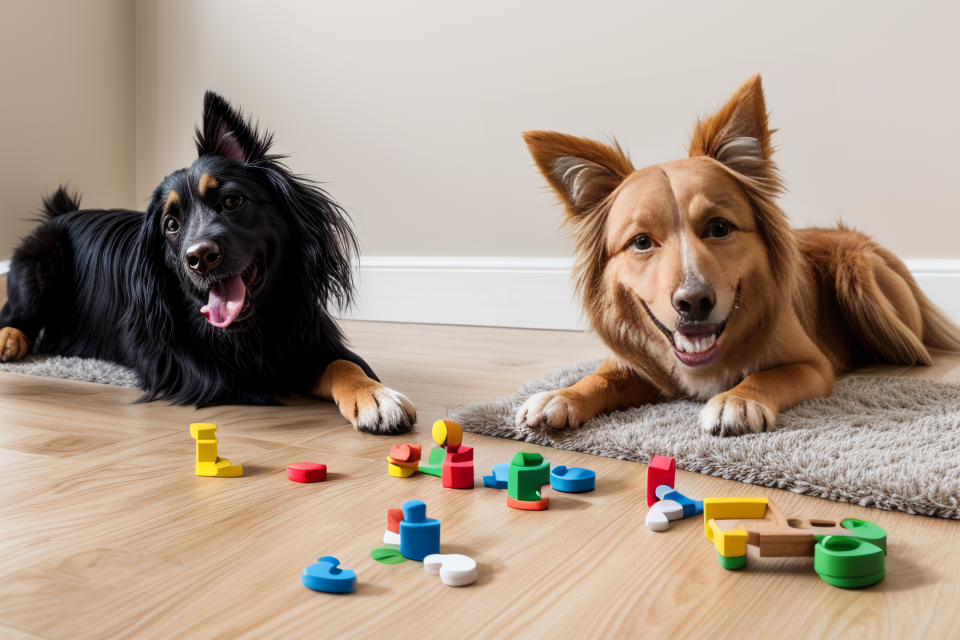Are you puzzled by your furry friend’s puzzle-solving skills? Wondering how long it should take your dog to complete a puzzle? Well, you’re not alone! Dogs have different abilities when it comes to puzzles, and their solving time can depend on various factors. In this article, we’ll explore the different aspects that can affect your dog’s puzzle-solving time and provide you with some valuable insights to help you understand and appreciate your dog’s unique abilities. So, let’s dive in and find out how long it should take your dog to solve a puzzle!
The amount of time it takes for your dog to solve a puzzle can vary depending on several factors such as the difficulty of the puzzle, your dog’s breed and intelligence, and their previous experience with similar puzzles. Some dogs may be able to solve a puzzle in just a few minutes, while others may take longer. It’s important to remember that every dog is different and there is no set time frame for how long it should take them to solve a puzzle. If you’re concerned about your dog’s puzzle-solving abilities, it’s always a good idea to consult with a veterinarian or a professional dog trainer for guidance.
Factors Affecting Puzzle Solving Time
Dog’s Age and Mental Maturity
Younger dogs
When it comes to puzzle-solving, age plays a significant role in determining how long it will take a dog to complete a task. Puppies, for example, are still developing their cognitive abilities and may struggle to solve puzzles that require more advanced problem-solving skills. As such, it may take them longer to figure out how to open a toy or access a hidden treat.
In general, younger dogs tend to have shorter attention spans and may become easily distracted, which can also impact their puzzle-solving abilities. However, this is not to say that younger dogs cannot benefit from puzzle toys. In fact, introducing puzzle toys to puppies can help stimulate their minds and improve their cognitive abilities as they grow older.
Older dogs
On the other hand, older dogs have had more time to develop their cognitive abilities and may be better equipped to solve puzzles. However, this does not necessarily mean that all older dogs will be able to solve puzzles quickly or easily.
Dogs who have had less mental stimulation throughout their lives may struggle with puzzles that require more advanced problem-solving skills. Similarly, dogs with certain medical conditions, such as cognitive dysfunction, may experience difficulty with puzzle-solving tasks.
In general, older dogs tend to have longer attention spans and may be more focused on the task at hand. However, it is important to note that each dog is unique and may have their own strengths and weaknesses when it comes to puzzle-solving.
Puzzle Difficulty
Simple puzzles
- Definition: Simple puzzles are those that require basic problem-solving skills and have a clear solution.
- Example: A puzzle with a single correct solution, such as pushing a button to open a treat dispenser.
- Time to solve: Typically, it should take less than a minute for a dog to solve a simple puzzle. However, the time may vary depending on the dog’s individual cognitive abilities and interest in the puzzle.
Complex puzzles
- Definition: Complex puzzles are those that require advanced problem-solving skills and may have multiple possible solutions or steps to complete the task.
- Example: A puzzle that requires the dog to manipulate multiple components or solve a series of steps to obtain a reward.
- Time to solve: The time to solve a complex puzzle can range from several minutes to over an hour, depending on the complexity of the puzzle and the dog’s individual abilities. Some dogs may be able to solve a complex puzzle more quickly than others, while others may require more time and repetition to figure it out.
Overall, the puzzle difficulty is a crucial factor that can affect the time it takes for a dog to solve a puzzle. Simple puzzles that require basic problem-solving skills should be easily solved within a minute, while complex puzzles that require advanced problem-solving skills may take longer to solve, depending on the dog’s individual abilities and interest in the puzzle.
Dog’s Previous Experience
Novice dogs
- Have not been exposed to puzzles before
- Lack of problem-solving skills
- Require more time to understand the puzzle
- May get frustrated easily
- Need repetitive exposure to puzzles to develop skills
Experienced dogs
- Have been exposed to puzzles multiple times
- Have developed problem-solving skills
- Understand the puzzle more quickly
- May solve the puzzle in a shorter amount of time
- May require more challenging puzzles to maintain interest
In general, a dog’s previous experience with puzzles can greatly impact how long it takes them to solve a puzzle. Novice dogs may take longer to solve a puzzle due to their lack of experience and problem-solving skills. On the other hand, experienced dogs may be able to solve puzzles more quickly due to their familiarity with the task. It is important to consider a dog’s previous experience when introducing them to puzzles and setting expectations for their problem-solving abilities. Providing repetitive exposure to puzzles can help novice dogs develop their skills and become more proficient puzzle solvers over time.
Motivation and Drive
Highly motivated dogs
Highly motivated dogs are likely to solve puzzles more quickly due to their strong desire to complete the task. These dogs are usually eager to please their owners and are highly attuned to their environment. They may have a strong prey drive, which can help them to focus on the puzzle and figure out how to open it.
Lowly motivated dogs
On the other hand, lowly motivated dogs may take longer to solve puzzles due to a lack of interest or drive. These dogs may not be as focused or engaged in the task, and may become easily distracted by other stimuli in their environment. They may also lack the problem-solving skills necessary to figure out how to open the puzzle.
In addition to these factors, a dog’s breed and individual personality can also play a role in how quickly they are able to solve puzzles. Some breeds, such as terriers and retrievers, may be more naturally inclined to problem-solving and may therefore be better at solving puzzles. Similarly, some dogs may be more intelligent or curious than others, which can also impact their puzzle-solving abilities.
Overall, a dog’s motivation and drive can have a significant impact on how quickly they are able to solve puzzles. Owners can encourage their dogs to stay motivated by providing positive reinforcement and making the puzzle-solving experience as enjoyable as possible.
Puzzle Toy Recommendations
Types of Puzzle Toys
Rotating puzzles
Rotating puzzles are a popular choice for dogs as they require the dog to manipulate the puzzle toy in order to access the treat. These puzzles come in a variety of shapes and sizes, and can be made from different materials such as plastic, metal, or wood. Some examples of rotating puzzles include the “Tug-a-Jug” and the “Flying Disc Game”.
Hiding puzzles
Hiding puzzles are designed to challenge a dog’s sense of smell. In these puzzles, treats are hidden in a compartment or chamber, and the dog must use their sense of smell to locate the treat. Some examples of hiding puzzles include the “Sniff Out a Treat” and the “Hidden Scent Game”.
Nose work puzzles
Nose work puzzles are designed to challenge a dog’s sense of smell and their problem-solving skills. In these puzzles, treats are hidden in a specific location, and the dog must use their sense of smell to locate the treat. Some examples of nose work puzzles include the “Snuffle Mat” and the “Nose Work Game”.
Memory puzzles
Memory puzzles are designed to challenge a dog’s memory and their ability to remember the location of treats. In these puzzles, treats are hidden in a specific location, and the dog must remember the location of the treats in order to find them later. Some examples of memory puzzles include the “Memory Game” and the “Treat Dispensing Puzzle”.
Choosing the Right Puzzle Toy
When it comes to choosing the right puzzle toy for your dog, there are several factors to consider. These include your dog’s age and mental maturity, experience with puzzle toys, and motivation and drive.
Consider your dog’s age and mental maturity
The age and mental maturity of your dog are important factors to consider when choosing a puzzle toy. Puppies, for example, may not have the cognitive abilities necessary to solve complex puzzles, while older dogs may become bored with simple puzzles. It’s important to choose a puzzle toy that is appropriate for your dog’s age and mental abilities.
Consider your dog’s experience with puzzle toys
If your dog has never used a puzzle toy before, it may take some time for them to learn how to solve it. On the other hand, if your dog has experience with puzzle toys, they may be able to solve more complex puzzles more quickly. When choosing a puzzle toy, consider your dog’s experience level and choose a toy that is challenging but not frustrating.
Consider your dog’s motivation and drive
Your dog’s motivation and drive can also play a role in how long it takes them to solve a puzzle. Dogs who are highly motivated by food may be more interested in solving a food-dispensing puzzle, while dogs who are more interested in play may prefer a puzzle toy that dispenses a toy or treat. Choose a puzzle toy that is motivating and engaging for your dog to help keep them interested and motivated to solve the puzzle.
Tips for Encouraging Puzzle Toy Engagement
Providing Incentives
One of the most effective ways to encourage your dog to engage with puzzle toys is by providing incentives. These incentives can come in the form of rewards, praise, and affection, and they play a crucial role in motivating your dog to solve the puzzle.
Rewarding success
One of the most straightforward ways to reward your dog for solving a puzzle is by giving them a treat. This could be a small piece of their favorite food or a special treat that they only get when they successfully complete the puzzle. The treat should be something that your dog really wants, so they will be motivated to work towards solving the puzzle.
Another way to reward success is by giving your dog verbal praise. When they successfully solve the puzzle, give them plenty of positive reinforcement. Tell them how proud you are of them, and give them plenty of pats and affection. This will make them feel good about themselves and will encourage them to keep trying.
Offering praise and affection
In addition to offering rewards, it’s also important to offer plenty of praise and affection to your dog when they are engaging with the puzzle toy. This will help to reinforce positive behavior and will encourage your dog to continue engaging with the toy.
When your dog is playing with the puzzle toy, make sure to watch them closely and offer plenty of praise and affection when they are making progress. This could be in the form of verbal praise, pats, or even playtime with their favorite toys. The more positive reinforcement your dog receives, the more likely they are to continue engaging with the puzzle toy.
It’s also important to make sure that your dog feels loved and valued when they are not engaging with the puzzle toy. This means giving them plenty of attention and affection when they are not playing with the toy, so they don’t feel like the puzzle toy is the only way they can receive love and attention from you.
Creating a Positive Association
Creating a positive association with puzzle toys is crucial to encouraging your dog to engage with them. Here are some tips to help you create a positive association:
Making puzzle time fun
- Introduce puzzle toys in a playful environment.
- Add a favorite toy or treat to the puzzle to make it more appealing.
- Play the puzzle toy with your dog and encourage them to join in.
Using puzzle time as bonding opportunity
- Use puzzle time as a chance to bond with your dog.
- Use puzzle time as a reward for good behavior.
- Incorporate puzzle time into your daily routine, so it becomes a familiar and enjoyable activity for your dog.
Keeping Puzzle Time Short and Frequent
Dogs have a short attention span, and it’s essential to keep them engaged for them to remain interested in puzzle toys. One way to do this is by keeping puzzle time short and frequent. This means giving your dog short bursts of puzzle time throughout the day instead of one long session. Here are some reasons why this approach works:
Short attention span
Dogs have a shorter attention span than humans, and they can quickly become bored or distracted. By giving them short bursts of puzzle time, you can keep them engaged without overwhelming them. This approach also allows them to take breaks between sessions, which can help prevent frustration and boredom.
Building up endurance
In addition to keeping your dog’s attention span in mind, it’s also important to build up their endurance over time. If your dog is new to puzzle toys, start with a few minutes of puzzle time per day and gradually increase the time as your dog becomes more comfortable and confident. This approach will help prevent frustration and boredom and will also help your dog build up their problem-solving skills over time.
It’s also important to note that every dog is different, and what works for one dog may not work for another. Some dogs may be more interested in puzzle toys for longer periods of time, while others may lose interest more quickly. It’s essential to pay attention to your dog’s behavior and adjust the puzzle time accordingly to ensure that they remain engaged and interested in the toys.
Adjusting the Difficulty Level
Adjusting the difficulty level of the puzzle toy is an essential factor in keeping your dog engaged. If the puzzle is too easy, your dog may quickly solve it and become bored. On the other hand, if the puzzle is too difficult, your dog may become overwhelmed and frustrated.
Overwhelmed dogs
If your dog is overwhelmed by the puzzle toy, it may take them longer to solve it. It’s essential to start with simple puzzles and gradually increase the difficulty level as your dog becomes more comfortable with the concept.
Some signs that your dog may be overwhelmed by the puzzle toy include:
- Your dog is struggling to figure out how to solve the puzzle
- Your dog becomes frustrated or stressed while trying to solve the puzzle
- Your dog loses interest in the puzzle toy
If your dog is overwhelmed, you can try the following tips:
- Start with a simpler puzzle toy and gradually increase the difficulty level
- Supervise your dog while they’re trying to solve the puzzle toy and offer encouragement
- Reward your dog with treats or praise when they solve the puzzle toy
Bored dogs
On the other hand, if your dog is bored with the puzzle toy, they may take longer to solve it or lose interest altogether. To prevent boredom, it’s essential to introduce new and challenging puzzles to keep your dog engaged.
Some signs that your dog may be bored with the puzzle toy include:
- Your dog quickly solves the puzzle toy without much effort
- Your dog becomes disinterested in playing with the puzzle toy
If your dog is bored, you can try the following tips:
- Introduce new and challenging puzzle toys to keep your dog engaged
- Rotate the puzzle toys to keep them interesting
- Mix up the puzzle toys with other types of toys to keep your dog engaged
Offering Variety
Introducing a variety of puzzle toys is essential to keep your dog engaged and prevent boredom. Here are some ways to achieve this:
- Rotate Puzzle Toys
Regularly changing the puzzle toys can stimulate your dog’s curiosity and challenge them to learn new problem-solving skills. This rotation will prevent them from getting too accustomed to one specific toy and keep their attention focused.
- Vary Difficulty Levels
Incorporating puzzle toys with different difficulty levels allows your dog to progress at their own pace. As they become more skilled, you can introduce more complex toys to continue stimulating their mind.
- Mix Up the Types of Puzzles
Offering a variety of puzzle types, such as hide-and-seek, nose work, and treat dispensing, can help maintain your dog’s interest and challenge them in different ways. This variety can also help satisfy their natural instincts, like their hunting or foraging instincts.
- Include Hidden Puzzles
Hiding puzzle toys in creative spots can add an extra element of challenge and excitement for your dog. This can also encourage them to use their problem-solving skills to locate the hidden toy.
- Experiment with Textures and Materials
Introducing puzzle toys made from different materials or featuring various textures can keep your dog engaged and interested. This can also help satisfy their natural curiosity and encourage them to use their sense of smell and touch while solving the puzzles.
By offering a variety of puzzle toys, you can ensure that your dog remains mentally stimulated and engaged, preventing boredom and helping them to continue developing their problem-solving skills.
Recap of Key Points
- Factors affecting puzzle solving time
- Breed and size of the dog
- Mental and physical ability
- Individual personality and interests
- Puzzle toy recommendations
- Interactive puzzles
- Hide-and-seek toys
- Dispensing toys
- Tips for encouraging engagement
- Gradual introduction
- Supervision
- Offering rewards and praise
When it comes to how long it should take for your dog to solve a puzzle, there are several factors to consider. One of the main factors is the breed and size of the dog. For example, larger breeds like German Shepherds may take longer to solve a puzzle than smaller breeds like Terriers.
Another factor is the dog’s mental and physical ability. Some dogs may be more intelligent and quicker at solving puzzles, while others may require more time and patience. Additionally, individual personality and interests can also play a role in how long it takes for a dog to solve a puzzle. A dog that is more interested in playing with the puzzle toy may take longer to solve it than a dog that is less interested.
When it comes to puzzle toy recommendations, there are several types of toys that can help encourage engagement and problem-solving skills. Interactive puzzles, such as the “Flying Dog” or “Snuffle Mat,” can provide mental stimulation and challenge dogs to figure out how to retrieve a reward. Hide-and-seek toys, like the “Hide-A-Squirrel” or “Tug-A-Treat,” can provide physical activity and encourage dogs to use their natural instincts to find and retrieve a reward. Dispensing toys, like the “Kong Wobbler” or “Nina Ottosson Dog Game,” can challenge dogs to figure out how to get a treat out of a toy by using problem-solving skills.
To encourage engagement with puzzle toys, it’s important to introduce them gradually and supervise your dog while they play. Offering rewards and praise can also help to motivate your dog and encourage them to continue playing with the puzzle toy.
Final Thoughts
Every dog is unique
It’s important to remember that every dog is unique and has their own individual learning style and problem-solving abilities. Some dogs may naturally be more inclined to puzzle-solving and may quickly master new toys, while others may require more time and patience to figure out how to get the treat. It’s important to observe your dog’s behavior and adjust the difficulty level of the puzzle toy accordingly.
Keep it fun and positive
Encouraging your dog to engage with puzzle toys should always be a fun and positive experience. Avoid setting unrealistic expectations or putting too much pressure on your dog to solve the puzzle quickly. Instead, make it a fun and rewarding activity by offering praise and treats for their efforts. Additionally, it’s important to rotate your dog’s puzzle toys regularly to keep them engaged and interested in problem-solving.
FAQs
1. How long should it take my dog to solve a puzzle?
The time it takes for your dog to solve a puzzle can vary depending on several factors such as the difficulty of the puzzle, your dog’s breed, age, and experience with puzzles, as well as its natural problem-solving abilities. Some dogs may solve a puzzle in just a few minutes, while others may take longer. It’s important to remember that every dog is different and there is no set time frame for how long it should take for your dog to solve a puzzle.
2. What factors can affect my dog’s ability to solve a puzzle?
Several factors can affect your dog’s ability to solve a puzzle, including its breed, age, and experience with puzzles. For example, certain breeds such as Border Collies and Shetland Sheepdogs are known for their intelligence and may excel at puzzles, while others may require more time and practice to become proficient. Additionally, a dog’s age can play a role in its ability to solve puzzles, with younger dogs typically having more energy and enthusiasm for problem-solving.
3. How can I make puzzles more challenging for my dog?
If you find that your dog is solving puzzles too quickly, there are several ways to make them more challenging. One option is to choose puzzles with higher levels of difficulty, such as those that require more steps to solve or have more complex rules. You can also try adding distractions, such as other toys or treats, to the area where the puzzle is located to see if your dog becomes more focused on those items instead of the puzzle. Finally, you can try increasing the size of the puzzle or adding more pieces to make it more challenging for your dog.
4. Are puzzles good for my dog’s mental stimulation?
Yes, puzzles can be a great way to provide mental stimulation for your dog. Solving puzzles can help keep your dog’s mind active and can help prevent boredom, which can lead to destructive behavior. Puzzles can also help improve your dog’s problem-solving skills and can provide a sense of accomplishment and satisfaction when it successfully solves a puzzle. In addition, puzzles can be a fun and engaging way to bond with your dog and can provide opportunities for interactive play.



